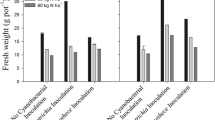Abstract
N2-fixing cyanobacteria (Anabaena azollae, symbiont strains) were immobilized in polyurethane foam and ammonia production by the cyanobacteria was investigated in the laboratory and rice field. The cyanobacterial symbiont, A. azollae - MPK-SK-AM-24 showed the highest growth rate and biomass production amongst the 5 isolates examined while A. azollae-AS-DS showed the highest nitrogenase activity followed by A. variabilis - SA0 (wild type, non-symbiotic). Treatment of the foam-immobilized cyanobacteria with the systemic fungicide Bavistin stimulated nitrogenase activity while inhibiting glutamine synthetase (GS) activity. Free-living A. azollae-MPK-SK-AF-38, A. azollae - MPK-SK-AM-24 and A. azollae-MPK-SK-AM-27 excreted the highest amounts of ammonia into the growth medium; under foam - immobilized conditions the ammonia production increased further. Treatment of the foam - immobilized cyanobacteria with the fungicides Bavistin and Vitavax resulted in ammonia production at significantly higher rates. Rice seedlings (var. ADT 36) grown in the laboratory in conjunction with foam - immobilized A. azollae showed increased growth. A field experiment with paddy rice and foam - immobilized A. azollae strains indicated that the cyanobacteria excreted significant amounts of ammonia into the flood water in the rice fields resulting in increased chlorophyll content of the plants and increased the rice grain and straw yields. A combination of fertilizer nitrogen and inoculation with foam - immobilized cyanobacteria also significantly increased the rice grain and straw yield. Additionally, both A. azollae and A. variabilis were immobilized in sugarcane waste (bagasse), added to rice paddy and resulted in increased rice grain yield.
Similar content being viewed by others
References
Brouers M, Hall DO (1986) Ammonia and hydrogen production by immobilized cyanobacteria. J. Biotechnol. 3: 307–321.
Brouers M, De Jong H, Shi DJ, Hall DO (1988) Immobilized cells: an appraisal of the methods and applications of cell immobilization techniques. In Cresswell RC, Rees TAV and Shah N (eds). Algal and Cyanobacterial Biotechnology, Longman, London: 272–293.
De PK (1939) The role of blue-green algae in nitrogen fixation in rice fields. Proceedings of Research Society of London. 127: 121–139.
Hardy RWF, Holsten RD, Jackson EK, Burns RC (1968) The acetylene reduction assays for N2 fixation: Laboratory and field evaluation. Plant Physiol. 43: 1185–1207.
Kamuru F, Albrecht SL, Baker JT, Allen LH, Shanmugam KT (1994) Growth responses of paddy rice to an ammonia excreting mutant cyanobacterium at elevated CO2 concentration. Appl. Soil Ecol. 1: 196–206.
Kannaiyan S (1985) Potentiality of Azolla biofertilizer for rice. In Mishra MM, Kapoor KK(eds), Soil Biology. Haryana Agric. Univ., Hisar, India: 253–259.
Kannaiyan S (1993) Nitrogen contribution by Azolla to rice crop. Proc. Indian Nat. Sci. Acad. B59: 309–314.
Kannaiyan S, Rao KK, Hall DO (1994) Immobilization of Anabaena azollae from Azolla filiculoides in polyvinyl foam for ammonia production in a photobioreactor system. World J. Microbiol. Biotechnol. 10: 55–58.
Kannaiyan S, Sopko B, Rao KK, Hall DO (1992) Ammonia excretion by the algal symbiont Anabaena azollae (AS-DS). In Kannaiyan S et al (eds), Biological Nitrogen Fixation and Biogas Technology. Tamil Nadu Agric. Univ., Tamil Nadu, India: 12–15.
Kerby NW, Musgrave SC, Shestakov SV, Stewart WDP (1986) Photoproduction of ammonium by immobilized mutant strains of Anabaena variabilis. Applied Microbiol. Biotechnol. 24: 42–45.
Kerby NW, Rowell P, Stewart WDP (1989) The transport, assimilation and production of nitrogenous compounds by cyanobacteria and microalgae. In Cresswell RC, Rees TAV and Shah N (eds). Algal and Cyanobacterial Biotechnology, Longman, London: 50–90.
Latorre C, Lee JH, Spiller H, Shanmugam KT (1986) Ammonium ion excreting cyanobacterial mutant as a source of nitrogen for growth of rice: A feasibility study. Biotechnol. Lett. 8: 507–512.
Peters GA, Kaplan D, Lough SA (1977) Azolla — Anabaena azollae relationship. V.15N2 fixation, acetylene reduction and H2 production. Plant. Physiol. 59: 1021–1025.
Roger PA, Kulasooriya S (1980) Blue Green Algae and Rice. Intl. Rice Res. Inst., P.O. Box 933, Manila 1099, Philippines, 112 pp.
Roger PA (1996) Biology and Management of the Floodwater Ecosystem in Rice fields. Intl. Rice Res. Inst., P.O. Box 933, Manila 1099, Philippines, 250 pp.
Samal KC, Kannaiyan S (1992) Ammonia excretion by Anabaena azollae immobilized in alginate and its effect on the growth of rice seedlings. Intl. Rice Research News Letters, Int. Rice Res. Inst., P.O. Box 933, Manila 1099, Philippines, 17: 21–22.
Shapiro BM, Stadman ER (1970) Glutamine synthetase (Escherchia coli). Methods in Enzymology 17A: 910–922.
Shi DJ, Hall D.O. (1988). The Azolla — Anabaena association. Historical perspective, symbiosis and energy metabolism. Bot. Rev. 54: 353–386.
Shi DJ, Hall DO, Tang PS (1987a) Photosynthesis, nitrogen fixation, ammonia photoproduction and structure of Anabaena azollae immobilized in natural and artificial systems. In Biggins J (ed.), Progress in Photosynthesis Research, vol. II. Martinus Nijhoff Publs, Dordrecht, 641–644.
Shi DJ, Brouers M, Hall DO, Robins RJ (1987b) The effects of immobilization on the biochemical, physiological and morphological features of Anabaena azollae. Planta 172: 298–308.
Solorzano L (1969) Determination of ammonia in natural waters by phenol hypochlorite method. Limnol. Oceanogr. 14: 799–801.
Stanier RY, Kunisawa R, Mandal M, Cohen-Bazire G (1971) Purification and properties of unicellular blue-green algae (order Chroococcales). J. Bact. 35: 171–305.
Wintermans JFGM, Demots A (1965) Spectrophotometric characteristic of chlorophylls-a and b and their phaeophytins in ethanol. Biochem. Biophys. Acta. 109: 448–453.
Author information
Authors and Affiliations
Rights and permissions
About this article
Cite this article
Kannaiyan, S., Aruna, S.J., Merina Prem Kumari, S. et al. Immobilized cyanobacteria as a biofertilizer for rice crops; Intl. Conference on Applied Algology, Knysna, South Africa, April 1996.. Journal of Applied Phycology 9, 167–174 (1997). https://doi.org/10.1023/A:1007962025662
Issue Date:
DOI: https://doi.org/10.1023/A:1007962025662




